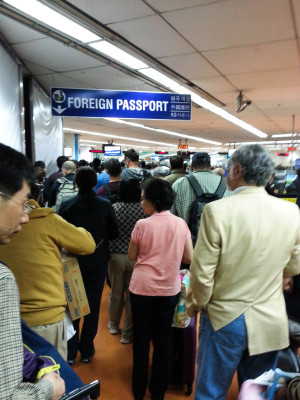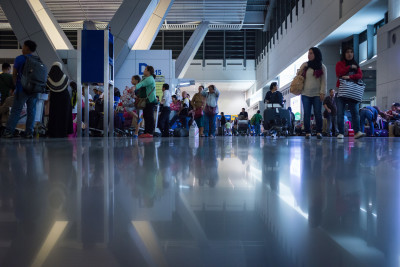Running on fumes

The company I work for regularly sends some of the management types over to China to oversee operations and to provide feedback from our customer base here in the States. These guys don’t exactly jump for joy whenever they get their travel documents and they’re usually pretty bad shape when they get back into the office. I always thought their lack of enthusiasm was probably because they’d been to China so many times that it had stopped being interesting or they just didn’t like the idea of going to another country just to work when they can just do that here.
Who knows, maybe it’s all of the above, but I have a sneaking suspicion that above all else, it’s the toll that trans-pacific travel takes on the human body. As I was planning my trip, I had a choice of either taking a third flight to Tacloban or landing in a different airport and taking a fast craft over to Leyte. Now this is not my first time traveling to the Far East, so I’m fairly familiar with the effects of long flights and while it is very tiring, I didn’t think one extra flight would make that much of a difference so I opted to fly into Tacloban, giving me a total of 3 flights to get to Leyte.
If I could do it all over again, I would have definitely reconsidered the third flight. Don’t get me wrong, the flight itself is a cinch; it’s only 1 hour to get from Manila to Tacloban so it wasn’t the ride that was the problem, it was everything else leading up to it. Here’s the breakdown of my entire trip:
- SFO to Incheon: 13 hours
- Layover in Incheon airport: 2.5 hours
- Incheon to Ninoy Aquino International Airport: 4 hours, 20 minutes
- Immigration, Baggage Claim, Customs, Money exchange, Terminal Transfer: 1 hour, 30 minutes
- Waiting to check in for domestic flight to Tacloban: 1 hour, 30 minutes
- Waiting for flight departure: 1 hour, 30 minutes
- Flight to Tacloban: 1 hour
- Waiting at van terminal: 1 hour, 30 minutes
- Van ride from Tacloban to Baybay: 2 hours, 30 minutes
That’s nearly 30 hours of being in transit and all in all, probably a total of 36 or more hours of going without REM sleep. I’ve always had a hard time sleeping during flights and it didn’t help that all of the flights either had bawling kids during the dark hours or the plane was experiencing turbulence.
However, the worst part of trying to get there is having to endure Ninoy Aquino International Airport (NAIA) Terminal 1, often referred to as NAIA1. The last time I went through Terminal 1 was back in 1994 when our family immigrated to the States, so all I knew about it were accounts from other travelers on Internet blogs like this one and from first hand experience from friends and family who traveled recently. Their testimonies are pretty much unanimous: NAIA1 will leave you hating life.
Unfortunately, their accounts were all accurate; NAIA1 is dilapidated, disorganized, and completely unfit for the volume of passengers it receives on a daily basis.
I will say without hesitation that NAIA1 makes the DMV look professional and courteous in comparison. The line for immigration was just a sea of humanity; Koreans, Americans, Europeans, Chinese, and Filipinos all suffering the same lack of A/C and wondering if they will ever survive to see the end of the line. This is one of those few moments where even paying for a First Class flight won’t save you from the indignity of rubbing elbows with the unwashed masses; in this place, we are all truly equal and endure together.
If you ever need to plan a connecting flight and it involves transferring from NAIA1, make sure you choose a flight that leaves at least 3 hours after your arrival, as an hour to get through immigration and baggage claim are not unheard of. Part of the reason the lines move so slowly is the inconsistency of the immigration officers; some appeared to be very efficient, passing one person in less than 5 minutes while others seem to have no idea what they’re doing.
And it was just my luck that I was in a line with a ditzy female immigration officer. I was waiting for my turn while the poor sap ahead of me was, for whatever reason, being held up by the IO. After about 10 minutes she eventually let him pass and when I walked up for my turn, she was far more interested in telling her coworker about her mistake with the previous person rather than processing my paperwork. I stood there for a good 2-3 minutes with my papers ready and a big, forced smile on my face waiting for her to finish entertaining (read: distracting) her fellow officer and actually do some work for a change. She eventually noticed me standing there and processed my papers quickly, after which she turned again to her coworker to laugh about her mistake. I don’t think this lady realizes how serious her job really is and the severity of the consequences should she pass someone with a stolen passport because she was too busy distracting her more efficient coworkers. The really depressing part is that these type of people are common in NAIA1; it’s more likely that you’ll run into an inept, lazy, rude or disgruntled employee rather than one that’s actually interested in doing what they’re being paid to do and leaving a good impression of the Filipino people in the hearts of foreign visitors.
It took about 30 minutes to get through immigration, then spent another 15 minutes waiting for my luggage to pop out onto the carousel. There were no issues with customs so I was able to breeze through that portion easily, but then had to face yet ANOTHER long line, this time for the currency exchange.
There was only one bank open that late in the evening and it moved even slower than immigration, but at least there was a legitimate reason for it. I later found out that the airport had its own currency exchange booths which weren’t immediately obvious when I got in line, they seemed to move much faster and their exchange rates were the same as the bank’s. I passed on it even after finding out since I didn’t want to run the risk of being handed a counterfeit bill; I figured there was less of a chance of that happening when dealing with a national bank.
With my wallet full of cash, I finally ventured out of the confines of the terminal building and into the balmy Manila midnight. Unlike most other airports in the world, NAIA requires travelers to make their own way if they need to transfer into the other terminals for domestic flights. For a while, they offered a free shuttle service, but it now charges P20. Originally, I planned on taking the shuttle to save some money but upon exiting the airport, I saw the length of the line (sensing a pattern here?) for the shuttle and I had to take a step back to reconsider my options. The shuttle takes 20 minutes to make its rounds through the 4 terminals and judging from the size of the bus, I assumed its capacity to be around 20-30 people max, not including luggage. The line was closer to 40-50 people so the shuttle would have to do at least two rounds before I could get in and I had no intentions of waiting in yet ANOTHER line for close to an hour so I ditched that idea and went for a metered taxi instead.
The yellow metered taxis are employed exclusively by the airport so there’s usually plenty of them around. It’s P70 to get in one plus whatever rate is accrued by the taxi’s meter; for a terminal transfer it should cost no more than P150. The cabs are fairly new Toyota economy cars and can hold 3 people plus one piece of luggage each; any more than that and you may have to take two cabs. The best part is that they’re air conditioned and since they’re small, they have an easier time navigating around the hectic Manila traffic. Since my flight arrived at midnight, there was very little traffic on the street and the trip only lasted 10 minutes. Before getting off, I asked the driver how much for the fare and like most Filipino drivers, he left it up to me how much to pay! I gave him a generous P20,0 which I know for a fact was way more than the meter would have totaled, and he gave me a sad puppy dog face in return. I caved and gave him another P40, but he mentioned why not a total of P300? At that point I decided to walk away before he guilt-tripped me out of all my cash; next trip I’ll ask him to give me the meter rate instead.
I also want to mention that if you are arriving or departing NAIA during the afternoon or early evening, be sure to budget enough time and cash for traffic. I had to make my way back to NAIA1 on my return trip home at around 8PM and there were no yellow taxis available because they were all stuck in traffic. Keep in mind that they only take on 1 passenger or 1 group if they’re all together at a time; so when taxis are trickling into the terminal once every 5-10 minutes and the line is 20-30 people deep, the wait can really wear on you.
My domestic flight was taking off from Terminal 3 at 4AM and I was there at 1AM with plenty of time to spare. Terminal 3 is NAIA’s largest and newest terminal, it officially opened for domestic flights back in 2008. It’s a world of difference from NAIA1; the design is reminiscent of other modern airports in the world and was designed from the ground up to handle a large volume of travelers. It’s such a shame that such a beautiful terminal sits mostly unused; there are several sections of the terminal that just collect dust. As of this time, NAIA3 handles mostly domestic traffic, though some international carriers have been moved to NAIA3 while NAIA1 is undergoing much needed renovations.
At around 2AM the check-in counters of Philippine Airlines finally opened and I was able to check my suitcase and get my ticket to Tacloban. In addition to being much larger than NAIA1, there are many more choices for dining, snacking and shopping at NAIA3. They even have a Burger King and a Wendy’s! I tried a BK Whopper just for kicks and amazingly, it’s exactly the same as its American counterpart! The bathrooms are also very clean and offer modern touches, like an air drier for hands and energy efficient lighting. My experience in NAIA3 was like night and day compared to NAIA1; if I had arrived here from my 13 hour flight and didn’t need to hire a taxi to another terminal for my domestic flight, I would have been in much better shape mentally and physically.
By the time I made it to the waiting area to run out remaining minutes until my flight to Tacloban, I was completely spent. I found myself nodding off and losing consciousness without even realizing it. Though the terminal has a security staff, I still didn’t feel 100% comfortable letting my guard down to take a nap, it was just too risky. For all I know someone could swipe my backpack or even my ticket as I slept and not won’t even notice until it’s time to board. And anyway, I had a lot to think about; Tacloban and Leyte is uncharted territory. There were so many unknowns and variables to consider that thinking about them was enough to snap me out of my drowsy stupor; however, that’s a post for another time.
To all the travelers out there, I implore you to avoid NAIA1 if at all possible. If you have to suffer your way through this airport, please try to keep an open mind when you experience sub-par quality service from the employees, because Pinoys ARE good workers. The bad eggs you run into in NAIA1 do not represent the Filipino people as a whole and I’m certain that you will run into honest, hard-working Filipinos during your time in the country, no matter how long or short your stay may be.


